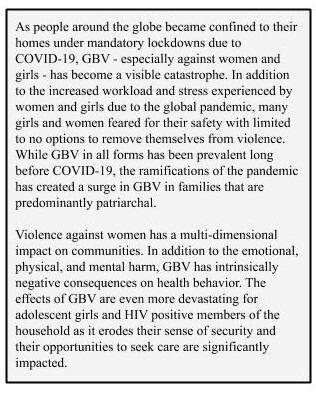The Intersectional Impact of GBV, HIV, and COVID-19 Lockdowns: How a Survivor Reclaimed Her Health and Life
By Simon Sensalire, Senior Learning and Adaptation Advisor

After a long and winding road to a community in Eastern Uganda, the WI-HER team, through the USAID Social Behavior Change Activity, visited a household to identify and close gender-related gaps to improve retention of and adherence to antiretroviral therapy (ART). Using WI-HER’s iDARE methodology, we found that gender-related barriers to health behaviors are hidden, deeply embedded in society, and can only be truly understood through a gender analysis.
iDARE involves identifying (I) the problem, designing (D) and applying (A) interventions to address the problem, recording results (R), and expanding (E) the interventions to scale. This is the story of a 15-year old gender-based violence (GBV) survivor we encountered, ‘Sarah,’[1] who grew up in a violent home, fled to survive during the COVID-19 pandemic, and how fleeing impacted her health.
Unfortunately, Sarah’s history of violence began long before the COVID-19 lockdown. In order to understand our GBV survivor’s choices, we must first understand her upbringing at home.
It began when the mother of Sarah, a widow, met her new partner, whom they started living with four years ago. The initially peaceful marriage sadly deteriorated into a house of violence, which disrupted the life of the children. The violence continued unabated as the perpetuator used his economic power and access to resources to exploit Sarah’s mother who was predominantly occupied in the caregiving duties for the household.
To combat the power dynamics and pursue financial self-reliance, Sarah’s mother started a small business selling agricultural products. She was motivated by the desire to meet the needs of her children and to afford necessary domestic items. This corresponds to assertions from feminist theory that enhanced female autonomy and power improves women’s bargaining power due to its association with women’s greater confidence, financial independence, and a lower likelihood of tolerating male domination and control at crisis point.
However, as the violence mounted, Sarah fled her home out of fear. She moved in with a 17-year-old male peer, ‘Peter,’ who eventually became her husband. Sarah is HIV positive and before fleeing her home, she was stable on ART and in good health. Due to the great disruption and change that occurred in her life that stemmed from violence, she stopped taking her medication. She missed appointments for prescription refills as well as her regular check-ups at the facility. With the increased level of violence in the home, Sarah had to make difficult choices to feel safe, which had a direct impact on her and her partner’s health.
Understanding the underlying gender issues to improve health outcomes
Due to our efforts to support the facility to improve follow up with persons living with HIV, we had the pleasure of meeting Sarah and Peter. We also met with her father-in-law ‘Joseph,’ who heads a household of more than 15 members all living in the same courtyard. We were first introduced to Sarah because of her lack of adherence to ART; however, due to WI-HER’s approach to understanding gender and social cultural issues, we understood the deep-rooted reasons for not adhering to treatment. We held a three-phased meeting within the courtyard first involving Sarah, then Sarah and Peter, and lastly Sarah, Peter, and Joseph. Through these meetings, we identified the history of violence in the survivor’s life, which further caused a chain of reactions that negatively impacted Sarah and her partner’s health.
WI-HER provided support to the facility to hold a short session of adherence counseling and education on HIV counseling and testing (HCT) with Sarah, Peter, and Joseph. The next strategy was to secure an HIV test for Peter and encourage Sarah to return to care. The impromptu counseling and education resulted in a plan that included a visit to the facility the following day for a pregnancy test for Sarah and HIV test for Peter, immediate resumption of treatment by Sarah, and condom use at the next sexual activity. Fortunately, Peter expressed a willingness to support Sarah through those challenging times. Joseph also expressed a willingness to support Peter and Sarah in order to achieve the action plan and monitor adherence.
Furthermore, Sarah’s mother was linked to a health provider for psycho-social support and GBV counseling. A linkage facilitator, who is an influential community member, was asked to follow up with Sarah’s step father, the perpetrator of GBV, and encourage him to go to the facility for an appointment aimed at providing couples counseling for GBV and clinical assessment.
The aftermath
After a month, a follow-up visit on the action plan found a more positive account. Sarah had resumed treatment and taken a pregnancy test, which turned out negative. Peter had tested negative and initiated on Pre-exposure Prophylaxis (PrEP), and the discordant couple was given adherence counseling. Peter and Sarah have since visited the facility together for each appointment and are adhering to treatment.
Although this experience came with its fair share of frustrations, it offers a successful end by bringing a lost client back to care. But that was not all we achieved.
We visited 13 other non-suppressed clients and determined various gender issues impacting their health decisions. We set up a team at the facility comprised of influencers in the community to support these individuals. It included health workers, youth, religious and cultural leaders, peers, the chairperson of the community/client-led ART delivery group, and a retired teacher. We co-designed activities with the team, such as following up with individual clients and sensitizing the community.
By leveraging the existing, trusted community structures; identifying gender issues; and designing targeted interventions to overcome these gender issues, we have supported half (50%) of the clients to achieve a suppressed viral load, while their appointment keeping improved from as low as 20% to 95% in two months and an adherence score of over 95%.
[1] To protect confidentiality, names have been changed throughout.